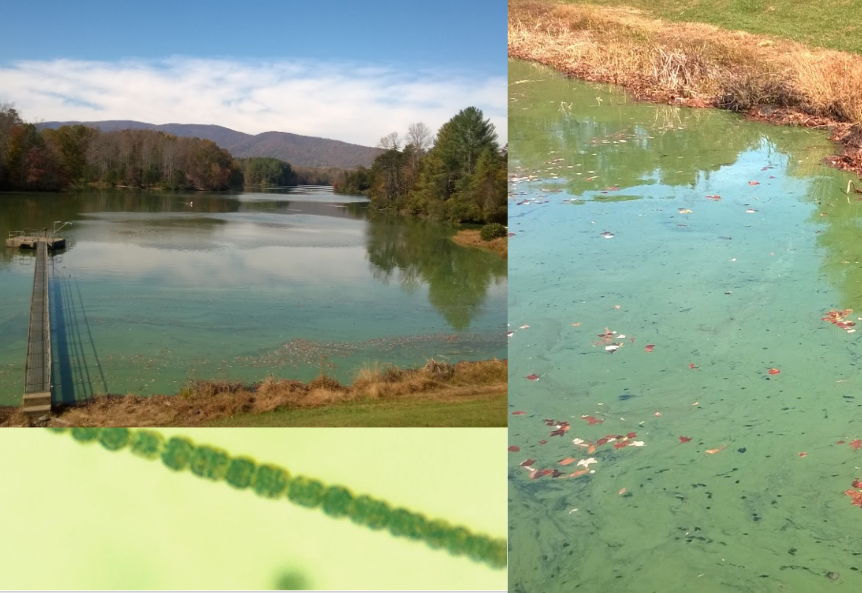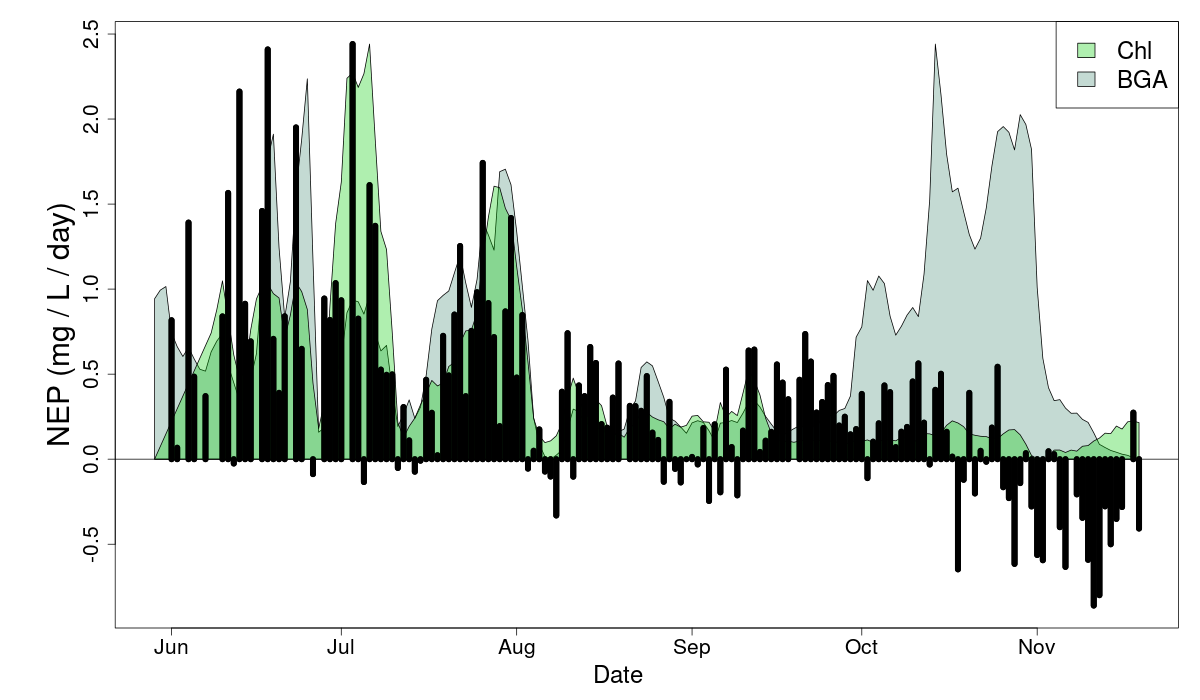Ecosystem Resilience & Regime Shifts
 Ecosystems are subject to constant pressure and disturbances from natural sources and human impacts. Resilience is the ability of an ecosystem to recover to its original state following a disturbance. Gradual or sudden decreases in ecosystem resilience can result in regime shifts - abrupt changes in the state of an ecosystem, due to transistions in the feedbacks that control system dynamics. These changes often seem to arise without warning, but theory suggests that regime shifts in a wide range of systems are preceded by predictable changes in system statistical properties. Much of my work as a research technician and graduate student has focused on developing and testing these methods using models and whole-lake experiments. I'm also currently working on a project quantifying estuary resilience and recovery time following hurricanes.
Ecosystems are subject to constant pressure and disturbances from natural sources and human impacts. Resilience is the ability of an ecosystem to recover to its original state following a disturbance. Gradual or sudden decreases in ecosystem resilience can result in regime shifts - abrupt changes in the state of an ecosystem, due to transistions in the feedbacks that control system dynamics. These changes often seem to arise without warning, but theory suggests that regime shifts in a wide range of systems are preceded by predictable changes in system statistical properties. Much of my work as a research technician and graduate student has focused on developing and testing these methods using models and whole-lake experiments. I'm also currently working on a project quantifying estuary resilience and recovery time following hurricanes.
Publications and Presentations:
- CD Buelo, SR Carpenter, ML Pace. 2018. A modeling analysis of spatial statistical indicators of thresholds for algal blooms. Limnology and Oceanography Letters.
- GM Wilkinson, SR Carpenter, JJ Cole, ML Pace, RD Batt, CD Buelo, JT Kurtzweil. 2018. Early warning signals precede cyanobacterial blooms in multiple whole-lake experiments. Ecological Monographs.
- ML Pace, RD Batt, CD Buelo, SR Carpenter, JJ Cole, JT Kurtzweil, GM Wilkinson. 2017. Reversal of a cyanobacterial bloom in response to early warnings. Proceedings of the National Academy of Sciences.
Algal Blooms
 Algae are a critical part of aquatic ecosystems, but in many systems an overabundance of algae leads to negative consequences. Algal blooms can produce dangerous toxins, and decomposition of blooms can draw down oxygen and cause fish kills. I study a variety of aspects of algal blooms, mostly at the ecosystem level: bloom drivers, quantitative near-term (days to weeks) bloom forecasting, ecosystem resilience and early warning indicators of blooms, impacts on ecosystem metabolism, and the occurrence of blooms at larger spatial and temporal scales. Often I use high-frequency, automated water quality sensor (sonde) data in my research, either from whole-lake fertilization experiments or monitoring programs in systems that regularly experience blooms.
Algae are a critical part of aquatic ecosystems, but in many systems an overabundance of algae leads to negative consequences. Algal blooms can produce dangerous toxins, and decomposition of blooms can draw down oxygen and cause fish kills. I study a variety of aspects of algal blooms, mostly at the ecosystem level: bloom drivers, quantitative near-term (days to weeks) bloom forecasting, ecosystem resilience and early warning indicators of blooms, impacts on ecosystem metabolism, and the occurrence of blooms at larger spatial and temporal scales. Often I use high-frequency, automated water quality sensor (sonde) data in my research, either from whole-lake fertilization experiments or monitoring programs in systems that regularly experience blooms.
Publications and Presentations:
- GM Wilkinson, JA Walter, CD Buelo, ML Pace. 2021. No evidence of widespread algal bloom intensification in hundreds of lakes. Frontiers in Ecology and the Environment.
- CD Buelo, N Nazemi. Forecasting Algal Blooms. School of Data Science Presidential Fellowship Presentation, May 2020.
- CD Buelo, ML Pace. Algal blooms and ecosystem metabolism in a managed drinking water reservoir. Univ. of Virginia Global Water Initiative Graduate Water Symposium Presentation, November 2019.
Ecosystem Metabolism
 Ecosystem metabolism represents the balance between energy creation (photosynthesis) and use (respiration), and in aquatic ecosystems is important for its impact on water quality, support of food webs, and role in carbon cycling. I research a variety of aspects of metabolism, including its drivers and impact on metabolic gas concentrations and emissions. Much of my work uses the "free-water method" for estimating lake or reservoir metabolism, using repeated measures of oxygen concentrations over a day to determine the integrated production and respiration of all organisms in a body of water.
Ecosystem metabolism represents the balance between energy creation (photosynthesis) and use (respiration), and in aquatic ecosystems is important for its impact on water quality, support of food webs, and role in carbon cycling. I research a variety of aspects of metabolism, including its drivers and impact on metabolic gas concentrations and emissions. Much of my work uses the "free-water method" for estimating lake or reservoir metabolism, using repeated measures of oxygen concentrations over a day to determine the integrated production and respiration of all organisms in a body of water.
Publications and Presentations:
- ML Pace, CD Buelo, SR Carpenter. 2021. Phytoplankton biomass, dissolved organic matter and temperature drive respiration in whole lake nutrient additions. Limnology and Oceanography.
- P Berg, ML Pace, CD Buelo. 2020. Air-water gas exchange in lakes and reservoirs measured from a moving platform by underwater eddy covariance. Limnology and Oceanography: Methods.
- GM Wilkinson, A Besterman, CD Buelo, J Gephart, ML Pace. 2018. A synthesis of modern organic carbon accumulation rates in coastal and aquatic inland ecosystems. Scientific Reports.
- GM Wilkinson, CD Buelo, JJ Cole, ML Pace. 2016. Exogenously produced CO2 doubles the CO2 efflux from three northern temperate lakes. Geophysical Research Letters.
Data Science
More of an approach to research than a distinct topic, I’m interested in the technical aspects of acquiring data and turning it into useful, actionable information. This interest started as a research technician studying statistical early warning indicators of an experimentally-induced algal bloom. Our study tested if changes in resilience could be detected and acted upon to prevent or reverse the bloom, and depended on collecting and analyzing high-frequency data each day and communicating quickly with the members of our research group. This experience taught me the value of creating tools/software/code that make analyses flexible, easy to do, and reproducible, which allows for quick iteration and sharing of findings.
